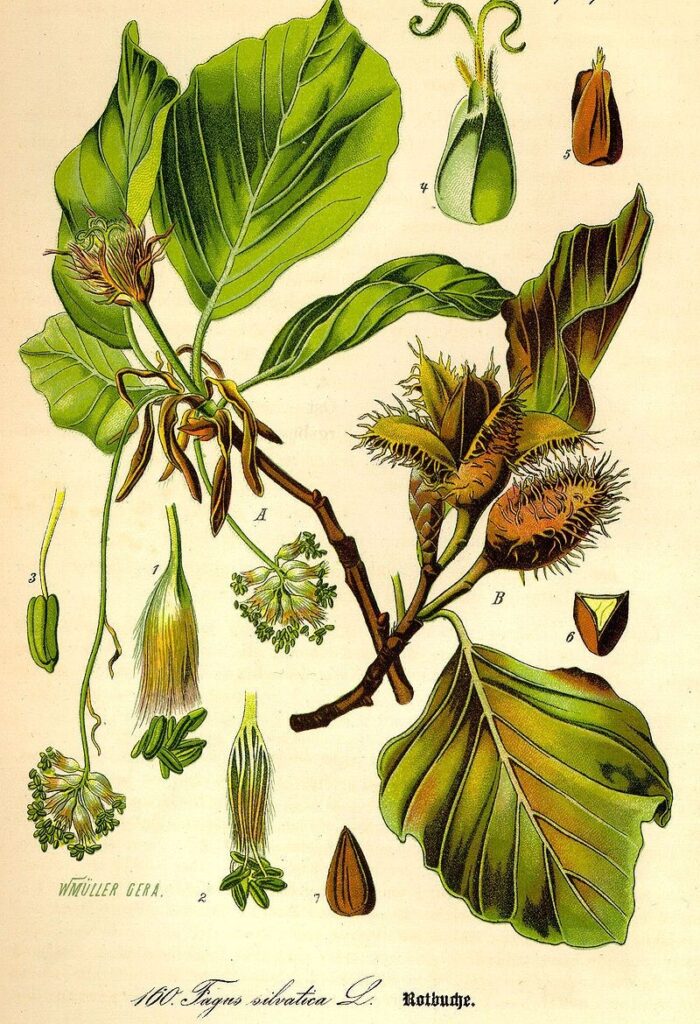Project initiated and carried out by RNP Romsilva - Covasna Forest Directorate in partnership with CovAlpin

The beech (Fagus sylvatica)
The beech is a size I tree, capable of reaching heights of 40 m and 2 m trunk diameter, although it is usually 25–35 m tall and trunk diameter up to 1.5 m. It is tall, imposing, with smooth, whitish-gray bark. A 10-year-old sapling will be about 4 m tall.
The beech has a lifespan of 150 to 200 years, although it sometimes lives up to 300 years.
The flowers are unisexual-monoecious (with male and female flowers on the same specimen) and flowering takes place in May.
The buds are 1-3 cm long, pointed towards the tip, with numerous brown scales, that appear in March.
The fruits are brown, triangular, encapsulated in two in spiny capsules, reddish-brown in color, they are called jir or nuts, which appear in autumn in October and are edible.
The leaves are bright dark green deciduous, covered with hairs, with a slightly widened, oval shape with jagged edges and a pointed tip; in autumn the leaves change color to brick-yellow, but some of the leaves remain on the tree until spring.
The stem is straight, the branches start from the base, the main ones are directed upwards, the crown is globular. The bark is smooth, grayish-white in colour, it is harvested in March from young greenish-brown and slightly hairy stems, the strips of bark dry in tied bundles, suspended in well-ventilated places.



Economic and ecological importance and use
The buds or acorns – the fruit of the beech tree – have been used since ancient times for certain oils, but also for feeding pigs (it is also highly valued by wild boars).
Beech bark is used to stop fever and as a bitter tonic, being one of the European equivalents of quinine, along with willow bark.
Beech tar is used in some skin diseases, as well as to cure respiratory ailments or to relieve their symptoms.
Beech wood was and is highly valued. As firewood it has a special quality, burning with little smoke and at a fairly high temperature, being used in the past in industrial furnaces, for example in the production of glass or iron. It has remained highly valued both in the construction and furniture industries, due to its strength, finesse of fibers and pleasant color.

Did you know that:
● The beech tree, once every 4-5 years, produces extra fruit (jir) so that the animals cannot consume them all and thus the forest perpetuates itself;
● Beech trees form a huge underground network of roots and fungi, which connect hundreds of trees, they form a spider web of hundreds of km, through which old trees and saplings communicate, transmitting carbon, nitrogen and water to them; they also reduce their roots to make room for the young and just before dying they transmit carbon dioxide and chemical signals that strengthen the community;
● The largest beech forest in Europe is in Semenic National Park, Cheile Caraşului;
● About 200 different species of mushrooms grow on the beech, some of which are even edible;
● Beech wood can easily rot if it is not protected by the tar made from its own bark;
● In Romania there is a so-called „beech-spruce” a 45-year-old tree, actually originating from a beech and a spruce in Câmpu lui Neag Locality, Gorj County
